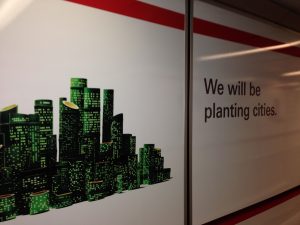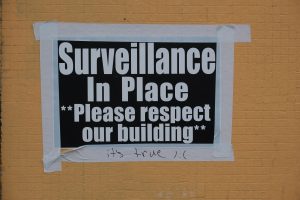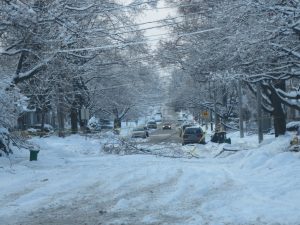By Roger Keil
Resilience is a tough and controversial term. Inspired by a recent invective by Tom Slater, in which he roundly rejects resilience as a concept and bemoans especially its use by the evil powers of regeneration and gentrification, I want to offer a few thoughts of my own. In a commentary on an article published by the new Guardian Cities platform, Slater calls resilience “the latest policy and think tank abomination to infect and paralyse the study of cities” and an “ideological twin of ‘sustainable urbanism’”. Moreover, “Resilience so easily supports not only austerity, but the territorial stigmatisation that so often precedes strategies of dislocation” and finally, Slater goes for the jugular: “Neoliberal urbanism has proved to be extraordinarily resilient, and the most “resilient community” of all appears to be that of a cartel of politicians and financial executives, aided by think tanks and philanthropic organisations, who have “bounced back” (to take the language used in the Guardian) from a crisis they created with even more violence and venom towards marginalised citizens (who they treat as the culprits) “.
 Slater’s takedown of ‘resilience’ is formidable but, while I share his concern about terminological whitewash and appreciate his intent to subject the term to a thorough ideology critique, I wonder if it tells the entire story. Slater is, of course, also not alone in slamming the term. Others, have contributed thoughtful pieces after thorough soul searching. Henrik Ernstson, for example, who has “used resilience theory as an analytical perspective before, or rather social-ecological systems theory, but [has] moved away from it” has bemoaned “how a social-ecological analytical perspective (heavily reliant on systems theory) has transformed into a normative language of policy of about almost anything.” Still others, like the great German planning theoretician Tom Sieverts, have put more confidence into resilience as he sees it as the guiding idea at the basis of a new “construction culture” that deals with the extensive, but largely unsustainable existing built environment in the face of climate change and socio-economic decline (as well as demographic shrinkage) in European cities. There are also observers who seem to be less concerned with the specific natural scientific histories or ideological implications but perhaps more by a pragmatic ethics of survival, as Abdoumaliq Simone seems to be when he talks about “the resilience and resourcefulness displayed by African cities, qualities drawn upon for local survival, but difficult to mobilize on a larger stage” (2005: 1).
Slater’s takedown of ‘resilience’ is formidable but, while I share his concern about terminological whitewash and appreciate his intent to subject the term to a thorough ideology critique, I wonder if it tells the entire story. Slater is, of course, also not alone in slamming the term. Others, have contributed thoughtful pieces after thorough soul searching. Henrik Ernstson, for example, who has “used resilience theory as an analytical perspective before, or rather social-ecological systems theory, but [has] moved away from it” has bemoaned “how a social-ecological analytical perspective (heavily reliant on systems theory) has transformed into a normative language of policy of about almost anything.” Still others, like the great German planning theoretician Tom Sieverts, have put more confidence into resilience as he sees it as the guiding idea at the basis of a new “construction culture” that deals with the extensive, but largely unsustainable existing built environment in the face of climate change and socio-economic decline (as well as demographic shrinkage) in European cities. There are also observers who seem to be less concerned with the specific natural scientific histories or ideological implications but perhaps more by a pragmatic ethics of survival, as Abdoumaliq Simone seems to be when he talks about “the resilience and resourcefulness displayed by African cities, qualities drawn upon for local survival, but difficult to mobilize on a larger stage” (2005: 1).
Yet, others have been more interested in what the term can do for progressive politics and I am curious about that, too. The Canadian New Democratic Party under its Urban Affairs Critic Matthew Kellway has launched a discussion draft white paper that relies heavily on the term. Asked to comment on the document and its treatment of resilience at a recent event, I had the following thoughts to offer. While this intervention is based on a longer conceptual paper on the matter and much empirical work on regional resilience in Toronto and Frankfurt which I am preparing for publication, these are preliminary thoughts meant to further debate and not a set framework of ideas.
At the beginning of this post, then, let me be clear about a few things in order not to create misunderstandings. I have always had a critical but overall favorable view of resilience’s “twin”, “sustainability” and I have applied the same careful critique to resilience. After first using sustainability actively when working on the GreenBelt in Frankfurt in the early 1990s (the city’s mayor Volker Hauff at the time was a member of the Brundtland commission that is often credited with popularizing the concept of sustainable development), I have often struggled with its uses and users, but have maintained a more positive than negative stance towards it and have done so on the record.
In a more recent contribution with Mark Whitehead, we have discussed the rise in popularity of the resilience discourse in the context of a post-sustainability conversation on urban futures. That review can be paraphrased as follows: Resilience is linked negatively to vulnerability: the less an urban region has of the former, the more it has of the latter. In the wake of recent urban disasters (terrorism, warfare, hurricanes, floods, pandemics), a “passion of the catastrophe” has gripped cities and their politics. The politics of nature in the city accordingly is has been increasingly about survival itself. Urban resilience thinking prioritizes the possibility that urban societies may be confronted by a series of severe changes that are not easy to predict, or to prevent. In this context, a politics of resilience openly recognizes that the time for achieving positively constructed sustainability has passed. Resilience thus prioritizes diversity (in relation to urban transport systems, energy generation, food production), modularity (in terms of energy delivery systems etc.), and tightness of feedbacks (or the ways in which transformations in one part of an urban system are recognized and responded to by others) The politics of resilience accepts, for example, that a new paradigm of ecological security and pandemic preparedness has emerged. But such a politics is not fatalist: it suggests, by contrast, that new forms of community cohesion, working together, local empowerment, and ecological intimacy can not only prepare cities for the worst of the twenty-first-century environment and economy, but also make urban life better. A more foundational political discourse has started to seep up through the bureaucratic, institutionalized practice of urban politics which, as may lead to “fabricating hope at the rim of the abyss” and admit, as Isabelle Stengers has suggested that “nothing will ‘save’ us if not our capacity to mend together the dispositifs of trial and error” (find full citations for this section here).
 I am not in love with “resilience” as a term. I am not a proselytizer of the resilience gospel. I am also well aware of the terrible use of the term by cynical neoliberal reformers who want to make people more resilient to their upsetting waves of austerity restructuring. But I am also taking the material challenges of survival in urban society seriously. Based on my work with Harris Ali on cities and infectious disease specifically, and guided by urban political ecological thinking and critical infrastructure research, I understand the necessity of adapting to catastrophic or creeping shock and decline, which may or may not be caused by neoliberalization. Life is a material force and it can be broken by material force. Resilience is part of the picture. I will explain.
I am not in love with “resilience” as a term. I am not a proselytizer of the resilience gospel. I am also well aware of the terrible use of the term by cynical neoliberal reformers who want to make people more resilient to their upsetting waves of austerity restructuring. But I am also taking the material challenges of survival in urban society seriously. Based on my work with Harris Ali on cities and infectious disease specifically, and guided by urban political ecological thinking and critical infrastructure research, I understand the necessity of adapting to catastrophic or creeping shock and decline, which may or may not be caused by neoliberalization. Life is a material force and it can be broken by material force. Resilience is part of the picture. I will explain.
Resilience is a beastly, not a cuddly concept. It snuggles up to power but will bite and scratch the common people. If we want to make it a useful tool, we need to tame it.
 Resilience is a dream concept for authoritarian governance as it gives a free pass to post-political managerialism at the expense of democratic deliberation. Since the Great Recession, resilience has been associated with the notion of “managing in hard times” under conditions of austerity and further state retrenchment and corporate attrition (Shaw and Maythorne 2013).
Resilience is a dream concept for authoritarian governance as it gives a free pass to post-political managerialism at the expense of democratic deliberation. Since the Great Recession, resilience has been associated with the notion of “managing in hard times” under conditions of austerity and further state retrenchment and corporate attrition (Shaw and Maythorne 2013).
The aftermath of the crises of the past few years came with a shift from opportunity to resilience. This entails two kinds of processes:
1. Resilience to specific threats is one dimension. It is now built into regional development strategies.
2. Globalization as a whole is considered a disastrous process. This moves resilience out of the opportunistic mode of response to a particular crisis event into a more systemic response mode.
Resilience is a new form of a late-neoliberal socio-ecological compromise that comprises ideas about social justice and environmental sustainability in a culture of consolidation and restraint. Following Coaffee et al. (2008), the implications are not necessarily openly statist and authoritarian but they can be more subtly neoliberal, working through the market, through civic institutions and through the individual: This often involves a process of “responsibilization [that] demands that such actors play an increasingly active role in their own self-government and risk management” (2008: 6). Among the specific processes that are involved are the management of multiple risks through enhanced institutional capacity and “the idea of urban territorial control, whereby the material and virtual form of the city is treated both as a source of risk and as a solution to its mitigation” (Ibid.).
 Like other concepts we have borrowed from biology, such as metabolism, ecology, sustainability, hybridity, etc., or from technology, such as cyborgs, resilience has being roundly criticized for making social reality look predetermined and undercomplex, as well as without agency. Yet the value of resilience lies in the fact that it has a hard core of biophysical relations and a soft shell of discursive constructions and societal relationships with nature. The hard core and the soft shell of resilience can work together in various and often mysterious ways.
Like other concepts we have borrowed from biology, such as metabolism, ecology, sustainability, hybridity, etc., or from technology, such as cyborgs, resilience has being roundly criticized for making social reality look predetermined and undercomplex, as well as without agency. Yet the value of resilience lies in the fact that it has a hard core of biophysical relations and a soft shell of discursive constructions and societal relationships with nature. The hard core and the soft shell of resilience can work together in various and often mysterious ways.
What we can retain is the fact that systemic resilience of communities, production systems, urban and suburban areas, etc. will rely on both, the soundness of the physical and structural environment and the right steering and regulatory mechanisms by which those environments are produced, maintained and projected into the future. In this sense, urban resilience refers to a set of material relations that sustain life in cities. I am leaving open to speculation what kind of life that might be and who benefits and loses as a consequence of its existence.
So, what I am ultimately not interested in is an ideological and speculative discussion about the hidden intentions of those people who use resilience in extant policy documents – including progressive attempts at using the term. This is not about ideology critique, it is an attempt at gauging the material value of a particular discursive intervention. Rather, I am curious about the potential of thinking about making life in cities better for a foreseeable time by disabling damaging processes associated with capitalist urbanization and at once by enabling processes of liberation and justice for sub/urban communities. Can we enlist resilience thinking into this project of building the enabling city to borrow a term from Chiara Camponeschi?
The question, quite simply, is why should we stick to the concept of resilience despite its spotty conceptual history and the shady friends it has had in the neoliberal regenerators? In my view, it is useful to keep the concept because it speaks to the core substantive concerns of urban society, both in the ephemeral and emphatic sense in which Henri Lefebvre used it and in the very pragmatic sense in which the NDP white paper re-defines Canada as an urban nation. Resilience is the core necessity of life in a post-carbon, post-industrial, and perhaps post-capitalist society where free, urbanized communities and individuals seek work, shelter, mobility, health, clean environments and social justice. Putting our cities on a path to resilience is a prerequisite for the possibilities urban society has to offer. If we fail at being resilient to the shocks that await us, we will not be able to leave the realm of necessity, and will not be able to enter the realm of possibility.
 Being resilient is both a material, socio-ecological necessity and a precondition for a perpetual “cry and demand” for a democratization and liberation of urban society. It is both substance and process which we cannot do without. In less philosophical and more pragmatic terms what I am asking here is whether we can envision a “resilience fix” the way we have thought previously about a “spatial fix” or a “sustainability fix”, i.e. a territorialization of strategies for the improvement of urban life over time, including the safeguarding of the necessary conditions for that life through forward looking and planning, through institutional fixes, and through the trigger of innovative processes that have a redistributive and democratizing dimension in reversal of the neoliberalizing tendencies of the last generation.
Being resilient is both a material, socio-ecological necessity and a precondition for a perpetual “cry and demand” for a democratization and liberation of urban society. It is both substance and process which we cannot do without. In less philosophical and more pragmatic terms what I am asking here is whether we can envision a “resilience fix” the way we have thought previously about a “spatial fix” or a “sustainability fix”, i.e. a territorialization of strategies for the improvement of urban life over time, including the safeguarding of the necessary conditions for that life through forward looking and planning, through institutional fixes, and through the trigger of innovative processes that have a redistributive and democratizing dimension in reversal of the neoliberalizing tendencies of the last generation.
We need to acknowledge right from the start that such a resilience fix may have considerably less to do with what we consider to be urban or suburban in form and structure, and might have much more to do with the positions of power and distribution of wealth in and between those places.
We might have to ask these questions:
- What are the processes, policies and politics through which resilience is envisioned and enacted?
- How are the processes that the turn to resilience requires being naturalized through the political discourse and practice at specific places?
We are left with a politics of resilience that needs to open themselves to both the internal contradictions of the urban region and its governance and the external uncertainties of globalization. So, the real existing resilience fix in which we are operating
- Does not have a singular, one-time set of actions
- Is not geared towards elusive equilibrium or status quo ante
- Offers to cities the chance to harness global opportunity when possible and to ask for local restraint and sacrifice when needed (around which distribution and recognition struggles will ensue)
- Triggers a dialectics of adaptation and adaptability where constraints in particular regional path dependencies are enmeshed with the opportunities of game changing challenges.
 How, then, finally can federal urban policy in Canada support resilience?
How, then, finally can federal urban policy in Canada support resilience?
It begins with the basics. Federal urban policy has historically produced the urban-suburban divide by prioritizing housing policies that enabled suburban sprawl. It can reverse this trend.
In coordination with the provinces, it can support regional policy over localist solutions.
Together with the provinces, the federal government can begin to address the stranglehold of private property capital over our cities and arrive at the support for more public use of urban land and infrastructures.
Key ingredients of a politics of resilience would entail:
- A federal employment program (beyond the oil and auto complex)
- A federal housing program (beyond the ownership of a single family home)
- A federal mobility program (beyond the automobile)
- A federal environmental program (beyond fossil dependency)
- A federal social policy (childcare, elder care)
Together, this would gel into a national policy of resilience. A policy of urban resilience at the scale of the medicare program of the past must be the foundation of urban Canada.
The resilience of cities cannot be produced by federal policy alone but it can be seeded. The work of creating a “resilience fix” will always be on the shoulders of urban societies locally and regionally. It will always be an unfinished project. And it will only succeed if it is driven by the principles of social justice and municipal democracy.
Sources:
Coaffee, J., Murakami Wood, D. & Rogers, P. (2008). The everyday resilience of the city: How cities respond to terrorism and disaster. New York: Palgrave.
Macmillan Shaw, K. & Maythorne, L. (2013). Managing for local resilience: Towards a strategic approach. Public Policy and Administration. 28 (1): 43-65.
Simone, A. (2005). Introduction: Urban Processes and Change, In A. Simone & A. Abouhani (eds.) Urban Africa: Changing Countours of Survival in the City. Dakar: Codesria Books, pp. 1-28.


2 comments on “Resilience: Not a cuddly kitten, more like a beastly cat”